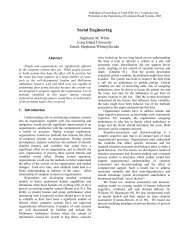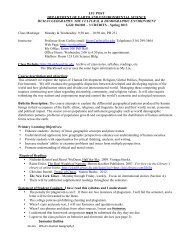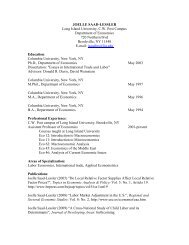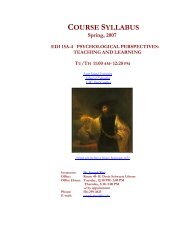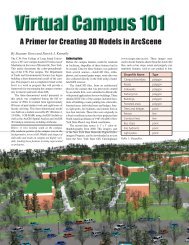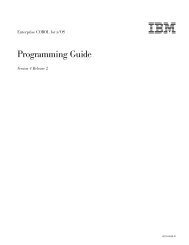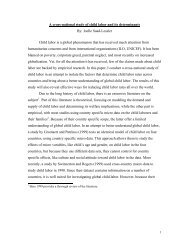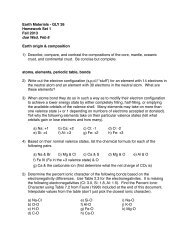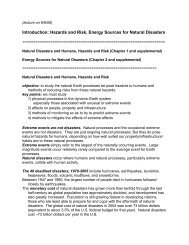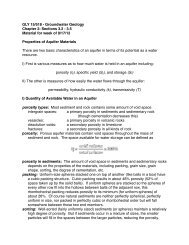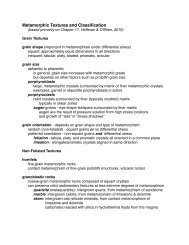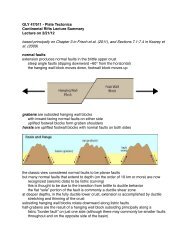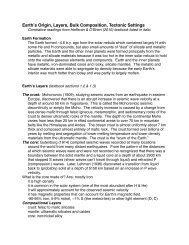Euler Poles and Triple Junctions - Myweb @ CW Post
Euler Poles and Triple Junctions - Myweb @ CW Post
Euler Poles and Triple Junctions - Myweb @ CW Post
Create successful ePaper yourself
Turn your PDF publications into a flip-book with our unique Google optimized e-Paper software.
GLY 47/511 - Plate Tectonics<br />
Framework of Plate Tectonics<br />
Lecture Summary<br />
Chapter 2 in Frisch et al. (2011), Section 5.3 & 5.8-5.11 in Kearey et al. (2009)<br />
See also Cox & Hart (1986)<br />
<strong>Poles</strong> of Rotation - <strong>Euler</strong> <strong>Poles</strong><br />
If the Earth were flat, we could describe the longterm motion of a plate as some straightline<br />
direction (e.g., NE or 53 degrees from due north). But because of the curvature of<br />
the Earth it is not that simple. Think, for example, how a plate may drift over the north<br />
or south pole. How, then would you describe its direction?<br />
One can describe the motion of a plate (or of a point) on a spherical Earth by way of a<br />
pole of rotation or <strong>Euler</strong>* pole (commonly pronounced "oiler"). Imagine an <strong>Euler</strong> pole<br />
as a pivot point. A plate moves about that pivot point with a set angular speed. It's like<br />
a dog chained to a peg anchored into the ground if it just runs around in a circle at the<br />
end of its chain.<br />
* Leonhard <strong>Euler</strong> was an 18th century, Swiss-born mathematician<br />
The part of a plate closest to the <strong>Euler</strong> pole moves slowest (in terms of distance in km)<br />
<strong>and</strong> the part of the plate farthest from the <strong>Euler</strong> pole moves the fastest. A point directly<br />
at the pole of rotation would rotate in place without actually moving off the spot. The<br />
velocity of a point at a given angular distance between the equator of rotation <strong>and</strong> the<br />
<strong>Euler</strong> pole of rotation of is simply the cosine of that distance multiplied times the<br />
maximum plate velocity at the equator of rotation,<br />
V α<br />
= V 0<br />
cosα<br />
where V0 is the maximum plate velocity at the equator of rotation<br />
α is the angular distance from the equator of rotation<br />
Note, just as the Earthʼs spin axis has 2 poles, there are 2 <strong>Euler</strong> poles of rotation on<br />
opposite sides of the Earth. The equator of rotation lies midway between these.<br />
On the Earthʼs surface, points on a plate (or midocean ridge separating 2 plates) that<br />
are less than 90° away from the pole of rotation move along small circles. Their motion<br />
looks like a curving path on the Earth. Points that are 90° from the pole of rotation<br />
move along a great circle path. Great circle paths are the shortest path between two<br />
points on the globe. They appear as straight line motion.
The <strong>Euler</strong> pole that defines the motion of a plate can be defined from the orientations of<br />
fracture zones. Spreading can be oblique to midocean ridge spreading centers so they<br />
are not good for defining <strong>Euler</strong> poles. The fracture zones themselves are flow lines.<br />
They show the direction(s) that a plate moved through time. Arcs drawn perpendicular<br />
to the fracture zones on a given plate will intersect at the plate's <strong>Euler</strong> pole. (see Fig.<br />
2.2 in Frisch et al. (2011) or Fig. 5.3 in Kearey et al. (2009)).<br />
Relative Plate Motion Directions<br />
midocean ridges: relative motion between 2 plates that spread away from one another<br />
at a ridge may be perpendicular to the ridge or oblique to the ridge<br />
trenches: the motion of a plate as it converges <strong>and</strong> subducts at a deep ocean trench<br />
may be perpendicular to the trench or oblique to it (oblique subduction)<br />
transform faults: the motions of 2 plates at a transform fault is almost always exactly<br />
parallel to the transform. (rarely, one may find slightly oblique motion - “leaky<br />
transforms”)<br />
<strong>Triple</strong> <strong>Junctions</strong><br />
Typically, we consider the motion of two plates relative to one another. We can<br />
determine the direction of relative plate motion from the orientation of transform faults/<br />
fracture zones along midocean ridges that separate the two plates. We can determine<br />
the rate of separation of the two plates using the pattern of marine magnetic anomalies<br />
that parallel the spreading ridges (using the known age of a reversal <strong>and</strong> the distance of<br />
the reversal from the midocean ridge).<br />
Commonly we are concerned with the relative motions of more than two plates. And<br />
since there are more than two plates on the Earthʼs surface (there are 12 major <strong>and</strong> a<br />
number of minor plates), there are points where three plates meet. These are called<br />
triple junctions. For example, three midocean ridges meet in the Indian Ocean where<br />
the African, Indo-Australian, <strong>and</strong> Antarctic plates meet.<br />
Ridge-Ridge-Ridge (RRR) triple junctions are always stable, whether the spreading<br />
rates on the 3 ridges are the same or different (e.g., Figs. 2.5 - 2.8 in Frisch et al.,<br />
2011)). The relative motion between three plates will be diagonal (oblique to the ridges)<br />
rather than at approximate right angles to the ridges (e.g., Fig. 2.5, Frisch et al., 2011).<br />
Other types of triple junctions may be stable (under given conditions) or unstable<br />
(regardless of exact configuration) <strong>and</strong> temporary <strong>and</strong> quickly transform into a different<br />
stable plate boundary configuration (Fig 5.27 in Kearey et al., 2009). Many triple<br />
junction combinations exist, including Trench-Trench-Trench (TTT) such as in the<br />
western Pacific, <strong>and</strong> Ridge-Trench-Transform Fault (RTF) such as along western North<br />
America.<br />
For the three plates (plates A, B, C) that meet at a triple junction, their three <strong>Euler</strong> poles<br />
(relative motion of A-B, B-C, <strong>and</strong> C-A) will fall on a great circle.



